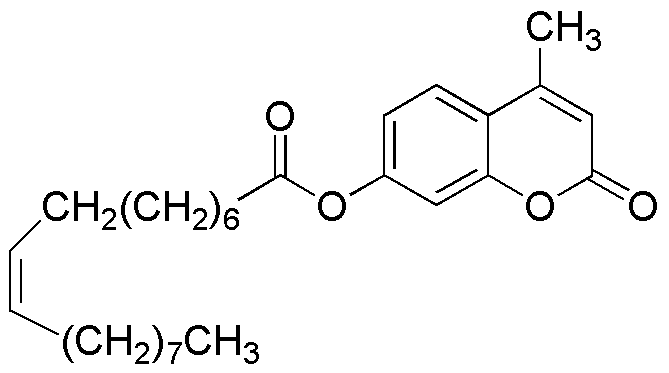4-Methylumbelliferyl oleate is widely utilized in research focused on:
- Enzyme Activity Assays: This compound serves as a substrate for various enzymes, allowing researchers to measure enzyme activity in biological samples. Its fluorescence upon hydrolysis provides a sensitive detection method.
- Cell Biology: It is used in cell culture studies to investigate lipid metabolism and membrane dynamics, helping scientists understand cellular processes and disease mechanisms.
- Food Industry: The compound can be applied in food science to study lipid oxidation, aiding in the development of better preservation methods and improving food quality.
- Pharmaceutical Research: It plays a role in drug formulation and testing, particularly in evaluating the bioavailability of lipid-based drugs, which can enhance therapeutic efficacy.
- Environmental Monitoring: 4-Methylumbelliferyl oleate can be used to assess the activity of microbial communities in environmental samples, providing insights into ecosystem health and pollution effects.
General Information
Properties
Safety and Regulations
Applications
4-Methylumbelliferyl oleate is widely utilized in research focused on:
- Enzyme Activity Assays: This compound serves as a substrate for various enzymes, allowing researchers to measure enzyme activity in biological samples. Its fluorescence upon hydrolysis provides a sensitive detection method.
- Cell Biology: It is used in cell culture studies to investigate lipid metabolism and membrane dynamics, helping scientists understand cellular processes and disease mechanisms.
- Food Industry: The compound can be applied in food science to study lipid oxidation, aiding in the development of better preservation methods and improving food quality.
- Pharmaceutical Research: It plays a role in drug formulation and testing, particularly in evaluating the bioavailability of lipid-based drugs, which can enhance therapeutic efficacy.
- Environmental Monitoring: 4-Methylumbelliferyl oleate can be used to assess the activity of microbial communities in environmental samples, providing insights into ecosystem health and pollution effects.
Documents
Safety Data Sheets (SDS)
The SDS provides comprehensive safety information on handling, storage, and disposal of the product.
Product Specification (PS)
The PS provides a comprehensive breakdown of the product’s properties, including chemical composition, physical state, purity, and storage requirements. It also details acceptable quality ranges and the product's intended applications.
Certificates of Analysis (COA)
Search for Certificates of Analysis (COA) by entering the products Lot Number. Lot and Batch Numbers can be found on a product’s label following the words ‘Lot’ or ‘Batch’.
*Catalog Number
*Lot Number
Certificates Of Origin (COO)
This COO confirms the country where the product was manufactured, and also details the materials and components used in it and whether it is derived from natural, synthetic, or other specific sources. This certificate may be required for customs, trade, and regulatory compliance.
*Catalog Number
*Lot Number
Safety Data Sheets (SDS)
The SDS provides comprehensive safety information on handling, storage, and disposal of the product.
DownloadProduct Specification (PS)
The PS provides a comprehensive breakdown of the product’s properties, including chemical composition, physical state, purity, and storage requirements. It also details acceptable quality ranges and the product's intended applications.
DownloadCertificates of Analysis (COA)
Search for Certificates of Analysis (COA) by entering the products Lot Number. Lot and Batch Numbers can be found on a product’s label following the words ‘Lot’ or ‘Batch’.
*Catalog Number
*Lot Number
Certificates Of Origin (COO)
This COO confirms the country where the product was manufactured, and also details the materials and components used in it and whether it is derived from natural, synthetic, or other specific sources. This certificate may be required for customs, trade, and regulatory compliance.


